Diatomite-Based Recyclable and Green Coating for Efficient Radiative Cooling
Abstract
1. Introduction
2. Materials and Methods
2.1. Design of the Diatomite-Based RCC
2.2. Preparation of the Hybrid RCC
2.3. Numerical Simulations
2.4. Optical Characterizations
2.5. Calculation of and
2.6. Outdoor Measurement
2.7. Net Cooling Power Calculation
3. Results and Discussion
3.1. Optical Properties of the Materials
3.2. Morphology and Optical Performance of the RCCs
3.3. Cooling Performance of the RCCs
3.4. Utility and Stability of the RCCs
3.5. Performance Comparison of the Diatomite-Based Coating with Other Works
4. Conclusions
Supplementary Materials
Author Contributions
Funding
Institutional Review Board Statement
Data Availability Statement
Conflicts of Interest
References
- Chua, K.J.; Chou, S.K.; Yang, W.M.; Yan, J. Achieving better energy-efficient air conditioning—A review of technologies and strategies. Appl. Energ. 2013, 104, 87–104. [Google Scholar] [CrossRef]
- Zahir, M.H.; Irshad, K.; Shafiullah, M.; Ibrahim, N.I.; Islam, A.K.M.K.; Mohaisen, K.O.; Sulaiman, F.A.A. Challenges of the application of PCMs to achieve zero energy buildings under hot weather conditions: A review. J. Energy Storage 2023, 64, 107156. [Google Scholar] [CrossRef]
- Ahmad, J.; Martínez-García, R.; de-Prado-Gil, J.; Irshad, K.; El-Shorbagy, M.A.; Fediuk, R.; Vatin, N.I. Concrete with partial substitution of waste glass and recycled concrete aggregate. Materials 2022, 15, 430. [Google Scholar] [CrossRef] [PubMed]
- Song, X.; Gao, Y.; Zhang, P. A bioinspired and scalable near-ideal broadband coating for radiative thermoregulation. J. Mater. Chem. A 2022, 10, 22166–22174. [Google Scholar] [CrossRef]
- Yin, X.; Yang, R.; Tan, G.; Fan, S. Terrestrial radiative cooling: Using the cold universe as a renewable and sustainable energy source. Science 2020, 370, 786–791. [Google Scholar] [CrossRef]
- Song, J.; Zhang, W.; Sun, Z.; Pan, M.; Tian, F.; Li, X.; Ye, M.; Deng, X. Durable radiative cooling against environmental aging. Nat. Commun. 2022, 13, 4805. [Google Scholar] [CrossRef]
- Raman, A.P.; Anoma, M.A.; Zhu, L.; Rephaeli, E.; Fan, S. Passive radiative cooling below ambient air temperature under direct sunlight. Nature 2014, 515, 540–544. [Google Scholar] [CrossRef]
- Zou, C.; Ren, G.; Hossain, M.M.; Nirantar, S.; Withayachumnankul, W.; Ahmed, T.; Bhaskaran, M.; Sriram, S.; Gu, M.; Fumeaux, C. Metal-Loaded Dielectric Resonator Metasurfaces for Radiative Cooling. Adv. Opt. Mater. 2017, 5, 1700460. [Google Scholar] [CrossRef]
- Zhai, Y.; Ma, Y.; David, S.N.; Zhao, D.; Lou, R.; Tan, G.; Yang, R.; Yin, X. Scalable-manufactured randomized glass-polymer hybrid metamaterial for daytime radiative cooling. Science 2017, 355, 1062–1066. [Google Scholar] [CrossRef]
- Wang, X.; Liu, X.H.; Li, Z.Y.; Zhang, H.; Yang, Z.; Zhou, H.; Fan, T. Scalable flexible hybrid membranes with photonic structures for daytime radiative cooling. Adv. Funct. Mater. 2020, 30, 1907562. [Google Scholar] [CrossRef]
- Wei, W.; Zhu, Y.; Li, Q.; Cheng, Z.; Yao, Y.; Zhao, Q.; Zhang, P.; Liu, X.; Chen, Z.; Xu, F.; et al. An Al2O3-cellulose acetate-coated textile for human body cooling. Sol. Energ. Mat. Sol. C. 2020, 211, 110525. [Google Scholar] [CrossRef]
- Dong, Y.; Han, H.; Wang, F.; Zhang, Y.; Cheng, Z.; Shi, X.; Yan, Y. A low-cost sustainable coating: Improving passive daytime radiative cooling performance using the spectral band complementarity method. Renew. Energ. 2022, 192, 606–616. [Google Scholar] [CrossRef]
- Huang, W.; Chen, Y.; Luo, Y.; Mandal, J.; Li, W.; Chen, M.; Tsai, C.; Shan, Z.; Yu, N.; Yang, Y. Scalable aqueous processing-based passive daytime radiative cooling coatings. Adv. Funct. Mater. 2021, 31, 2010334. [Google Scholar] [CrossRef]
- Xiang, B.; Zhang, R.; Luo, Y.; Zhang, S.; Xu, L.; Min, H.; Tang, S.; Meng, X. 3D porous polymer film with designed pore architecture and auto-deposited SiO2 for highly efficient passive radiative cooling. Nano Energy 2021, 81, 105600. [Google Scholar] [CrossRef]
- Xue, X.; Qiu, M.; Li, Y.; Zhang, Q.M.; Li, S.; Yang, Z.; Feng, C.; Zhang, W.; Dai, J.; Lei, D.; et al. Creating an eco-friendly building coating with smart subambient radiative cooling. Adv. Mater. 2020, 32, 1906751. [Google Scholar] [CrossRef] [PubMed]
- Du, T.; Niu, J.; Wang, L.; Bai, J.; Wang, S.; Li, S.; Fan, Y. Daytime Radiative Cooling Coating Based on the Y2O3/TiO2 Microparticle-embedded PDMS polymer on energy-saving buildings. ACS Appl. Mater. Interfaces 2022, 14, 51351–51360. [Google Scholar] [CrossRef] [PubMed]
- Mandal, J.; Fu, Y.; Overvig, A.C.; Jia, M.; Sun, K.; Shi, N.N.; Zhou, H.; Xiao, X.; Yu, N.; Yang, Y. Hierarchically porous polymer coatings for highly efficient passive daytime radiative cooling. Science 2018, 362, 315–319. [Google Scholar] [CrossRef]
- Tao, M.; Liu, F.; Ma, B.; Xue, L. Effect of solvent power on PVDF membrane polymorphism during phase inversion. Desalination 2013, 316, 137–145. [Google Scholar] [CrossRef]
- Rashid, M.M.; Tavcer, P.F.; Tomsic, B. Influence of Titanium Dioxide nanoparticles on human health and the environment. Nanomaterials 2021, 11, 2354. [Google Scholar] [CrossRef]
- Yu, Z.; Wang, Y.; Liu, X.; Sun, J.; Sha, G.; Yang, J.; Meng, C. A novel pathway for the synthesis of ordered mesoporous silica from diatomite. Mater. Lett. 2014, 119, 150–153. [Google Scholar] [CrossRef]
- Li, T.; Zhai, Y.; He, S.; Gan, W.; Wei, Z.; Heidarinejad, M.; Dalgo, D.; Mi, R.; Zhao, X.; Song, J.; et al. A radiative cooling structural material. Science 2019, 364, 760–763. [Google Scholar] [CrossRef]
- Choi, S.H.; Kim, S.; Ku, Z.; Visbal-Onufrak, M.A.; Kim, S.R.; Choi, K.H.; Ko, H.; Choi, W.; Urbas, A.M.; Goo, T.W.; et al. Anderson light localization in biological nanostructures of native silk. Nat. Commun. 2018, 9, 452. [Google Scholar] [CrossRef]
- Zhang, H.; Ly, K.C.S.; Liu, X.; Chen, Z.; Yan, M.; Wu, Z.; Wang, X.; Zheng, Y.; Zhou, H.; Fan, T. Biologically inspired flexible photonic films for efficient passive radiative cooling. Proc. Natl. Acad. Sci. USA 2020, 117, 14657–14666. [Google Scholar] [CrossRef] [PubMed]
- Liu, X.; Xiao, C.; Wang, P.; Yan, M.; Wang, H.; Xie, P.; Liu, G.; Zhou, H.; Zhang, D.; Fan, T. Biomimetic photonic multiform composite for high-performance radiative cooling. Adv. Opt. Mater. 2021, 9, 2101151. [Google Scholar] [CrossRef]
- Li, C.; Wang, M.; Xie, B.; Ma, H.; Chen, J. Enhanced properties of diatomite-based composite phase change materials for thermal energy storage. Renew. Energy 2020, 147, 265–274. [Google Scholar] [CrossRef]
- Lv, P.; Liu, C.; Rao, Z. Review on clay mineral-based form-stable phase change materials: Preparation, characterization and applications. Renew. Sust. Energ. Rev. 2017, 68, 707–726. [Google Scholar] [CrossRef]
- Li, X.; Peoples, J.; Yao, P.; Ruan, X. Ultrawhite BaSO4 paints and films for remarkable daytime subambient radiative cooling. ACS Appl. Mater. Interfaces 2021, 13, 21733–21739. [Google Scholar] [CrossRef]
- Cheng, Z.; Han, H.; Wang, F.; Yan, Y.; Shi, X.; Liang, H.; Zhang, X.; Shuai, Y. Efficient radiative cooling coating with biomimetic human skin wrinkle structure. Nano Energy 2021, 89, 106377. [Google Scholar] [CrossRef]
- Hossain, M.; Gu, M. Radiative Cooling: Principles, Progress, and Potentials. Adv. Sci. 2016, 3, 1500360. [Google Scholar] [CrossRef]
- Gentle, A.; Smith, G. Optimized infra-red spectral response of surfaces for sub-ambient sky cooling as a function of humidity and operating temperature. In Proceedings of the SPIE 7725, Photonics for Solar Energy Systems III, Brussels, Belgium, 18 May 2010. [Google Scholar]
- Liu, R.; Zhou, Z.; Mo, X.; Liu, P.; Hu, B.; Duan, J.; Zhou, J. Green-manufactured and recyclable coatings for subambient daytime radiative cooling. ACS Appl. Mater. Interfaces 2022, 14, 46972–46979. [Google Scholar] [CrossRef]
- Chen, Y.; Dang, B.; Fu, J.; Wang, C.; Li, C.; Sun, Q.; Li, H. Cellulose-based hybrid structural material for radiative cooling. Nano Lett. 2021, 21, 397–404. [Google Scholar] [CrossRef] [PubMed]

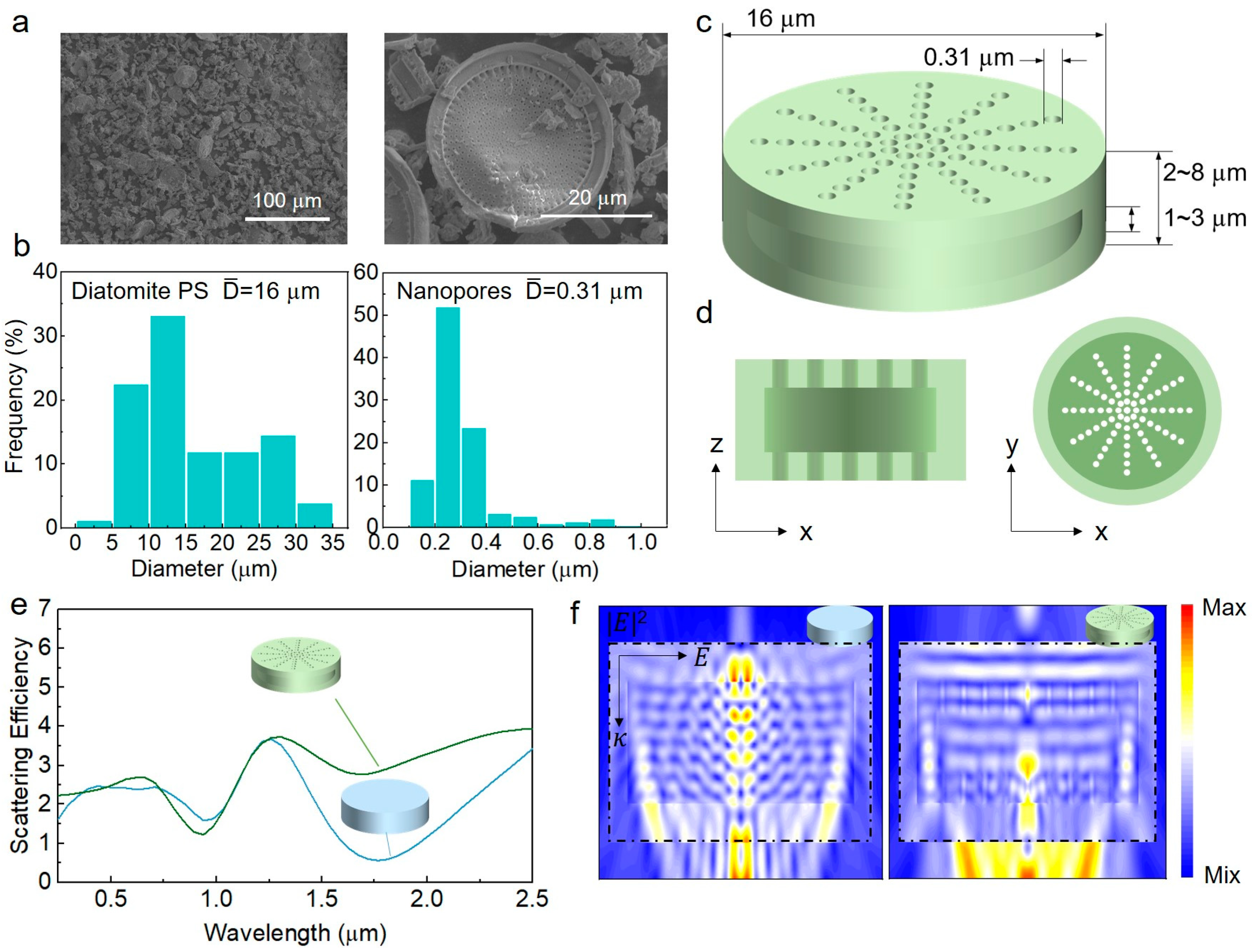
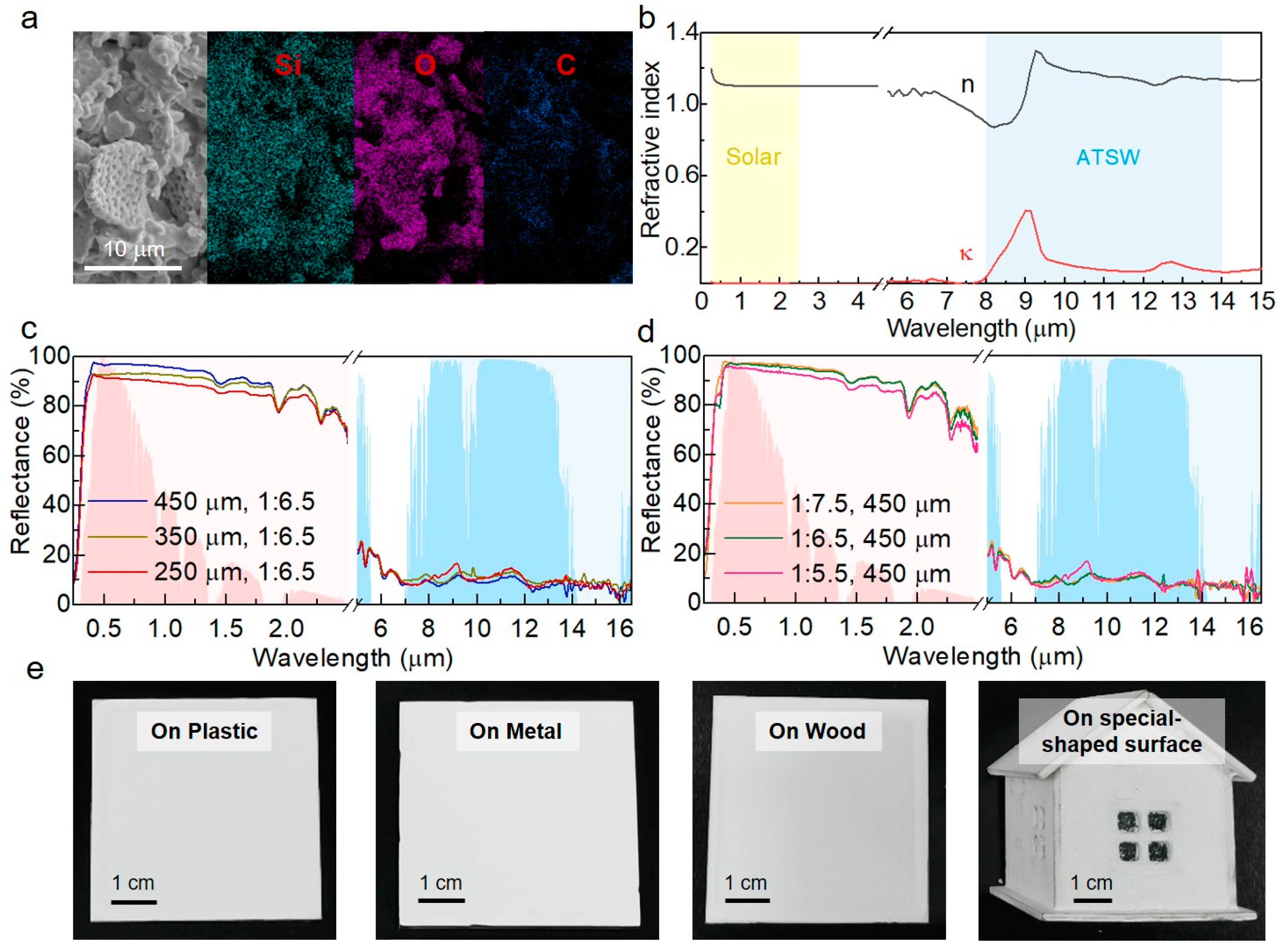

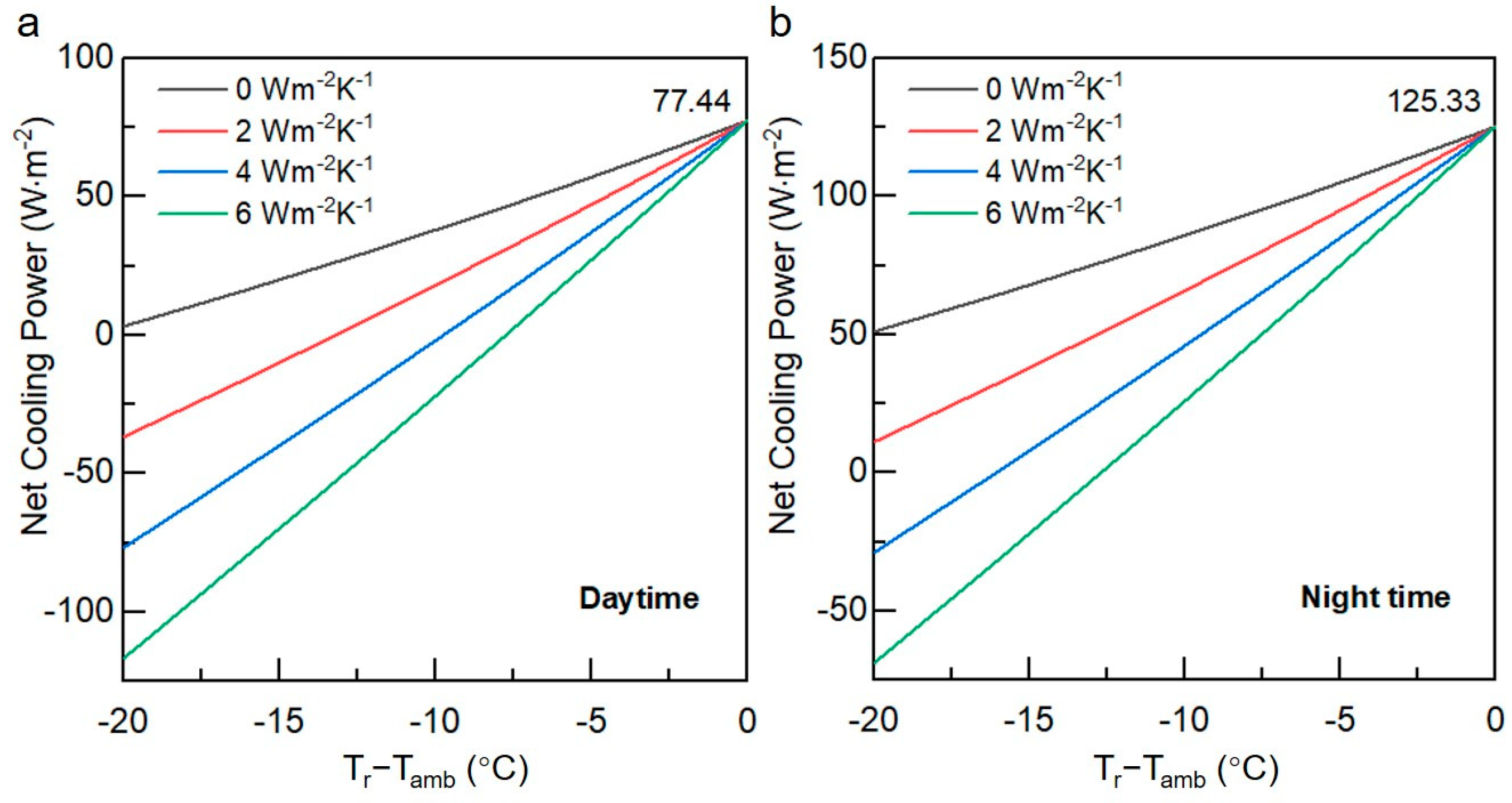
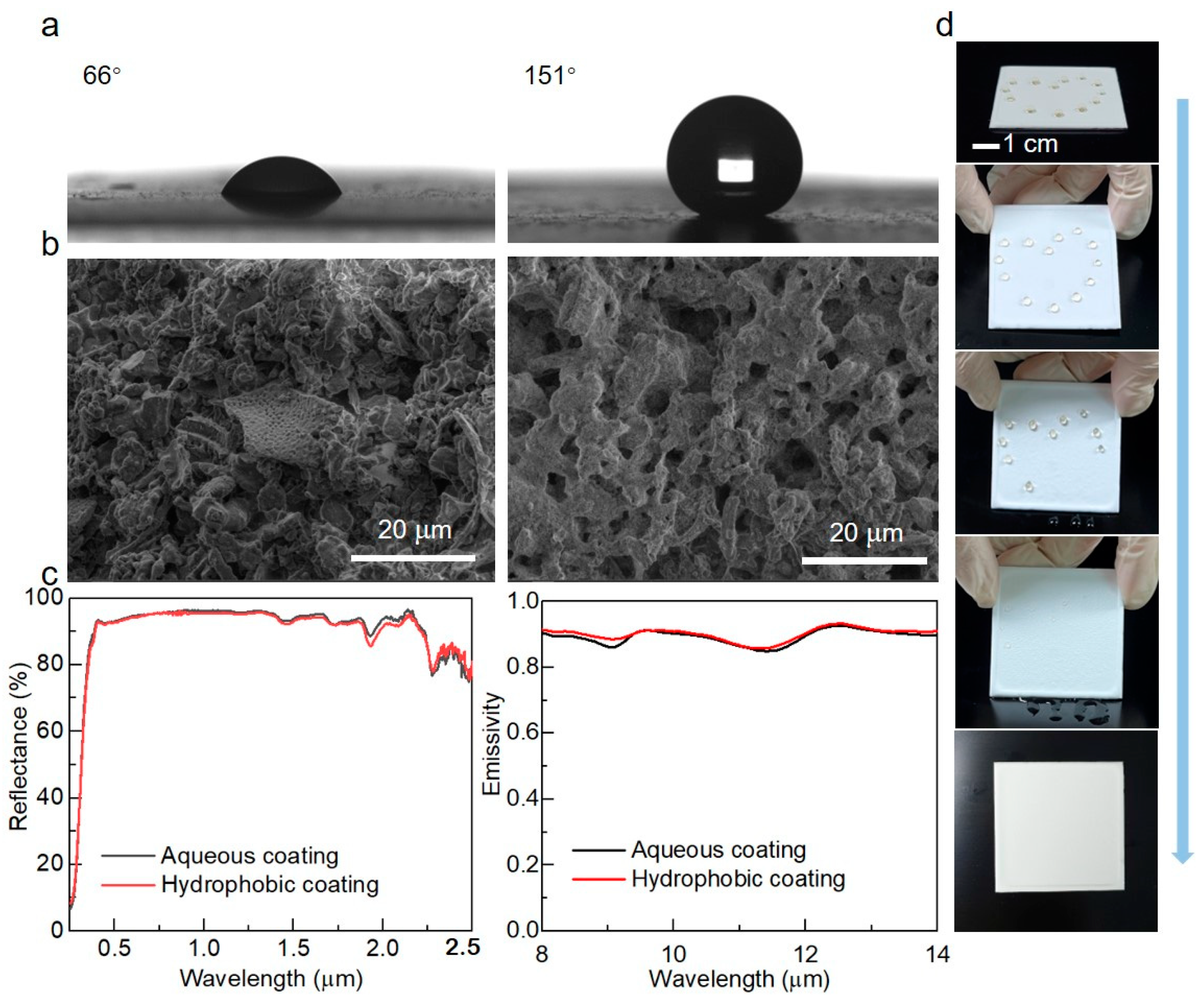
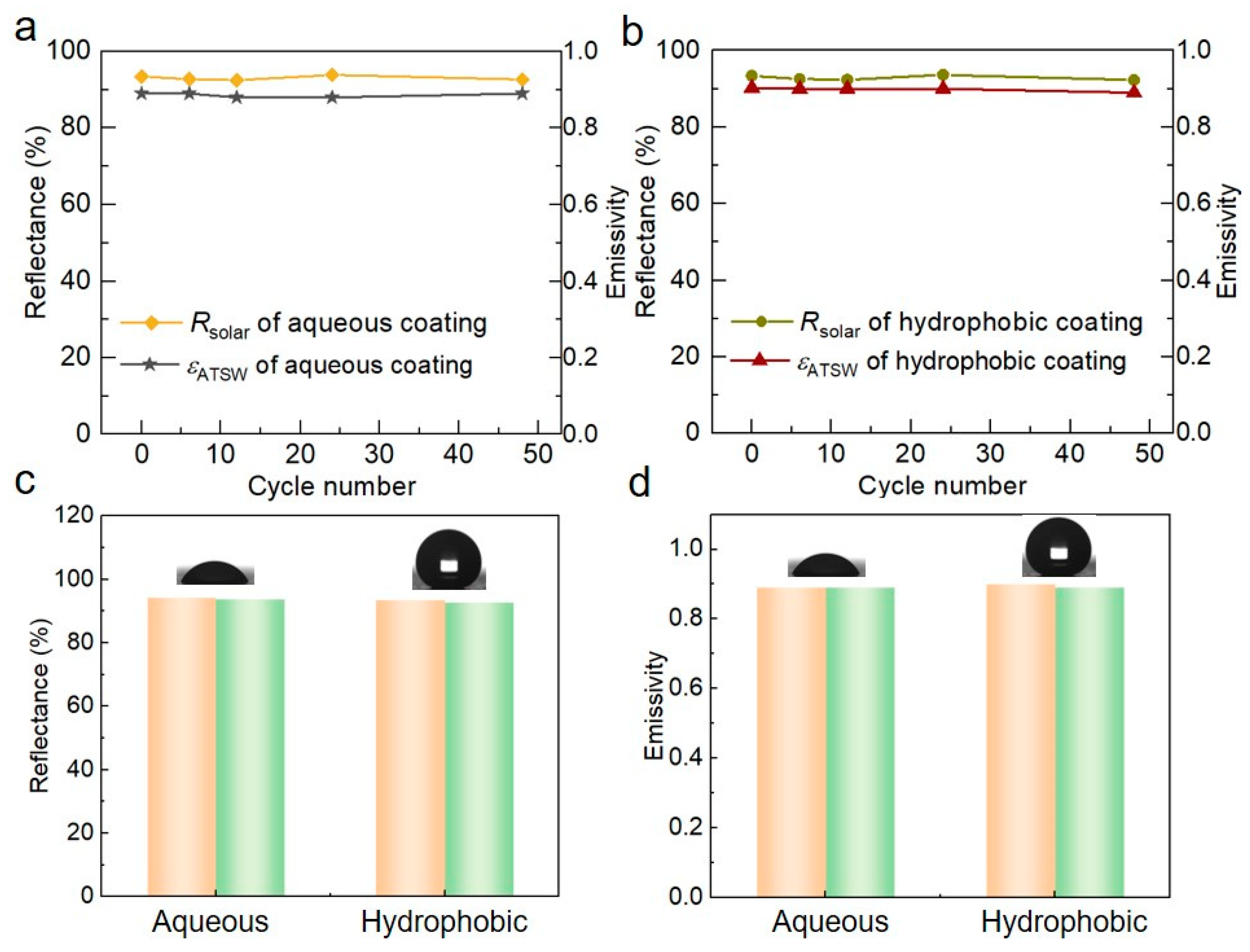
| Author | Material | Thickness (μm) | (%) | Testing Time | Temperature Drop (°C) | Use of Unsafe Solvent/Additive |
|---|---|---|---|---|---|---|
| This work | Diatomite/Methyl cellulose | 450 | 94 | ~12:00–14:00 | 6.1 (Max) 4.1 (Avg) | None |
| Song et al. [4] | PVDF/PVDF–HFP | 2 mm | 96 | ~12:00 | 2.2 | Acetone |
| Huang et al. [13] | P(VdF-HFP) | 500 | 94 | 12:30–14:00 | 1.7 1 (Avg) | Sodium dodecyl sulfonate |
| Du et al. [16] | Y2O3/TiO2/PDMS | 150 | 92.2 | 10:00–14:00 | 7.7 (Avg) | N-hexane |
| Li et al. [21] | Wood | / | 97 (400–700 nm) | 11:00–14:00 | >4 (Avg) | H2O2 |
| Chen et al. [32] | SiO2/Cellulose | 4 mm | 94 | noon | 6 | Hydrofluoric acid |
| Liu et al. [31] | BaSO4/Ethyl cellulose | 700 | 98.6 | noon | >2.5 | Ethanol |
Disclaimer/Publisher’s Note: The statements, opinions and data contained in all publications are solely those of the individual author(s) and contributor(s) and not of MDPI and/or the editor(s). MDPI and/or the editor(s) disclaim responsibility for any injury to people or property resulting from any ideas, methods, instructions or products referred to in the content. |
© 2024 by the authors. Licensee MDPI, Basel, Switzerland. This article is an open access article distributed under the terms and conditions of the Creative Commons Attribution (CC BY) license (https://creativecommons.org/licenses/by/4.0/).
Share and Cite
Lu, J.; Fan, Y.; Lou, X.; Xie, W.; Zhao, B.; Zhou, H.; Fan, T. Diatomite-Based Recyclable and Green Coating for Efficient Radiative Cooling. Biomimetics 2024, 9, 50. https://doi.org/10.3390/biomimetics9010050
Lu J, Fan Y, Lou X, Xie W, Zhao B, Zhou H, Fan T. Diatomite-Based Recyclable and Green Coating for Efficient Radiative Cooling. Biomimetics. 2024; 9(1):50. https://doi.org/10.3390/biomimetics9010050
Chicago/Turabian StyleLu, Jing, Yile Fan, Xing Lou, Wei Xie, Binyuan Zhao, Han Zhou, and Tongxiang Fan. 2024. "Diatomite-Based Recyclable and Green Coating for Efficient Radiative Cooling" Biomimetics 9, no. 1: 50. https://doi.org/10.3390/biomimetics9010050
APA StyleLu, J., Fan, Y., Lou, X., Xie, W., Zhao, B., Zhou, H., & Fan, T. (2024). Diatomite-Based Recyclable and Green Coating for Efficient Radiative Cooling. Biomimetics, 9(1), 50. https://doi.org/10.3390/biomimetics9010050






